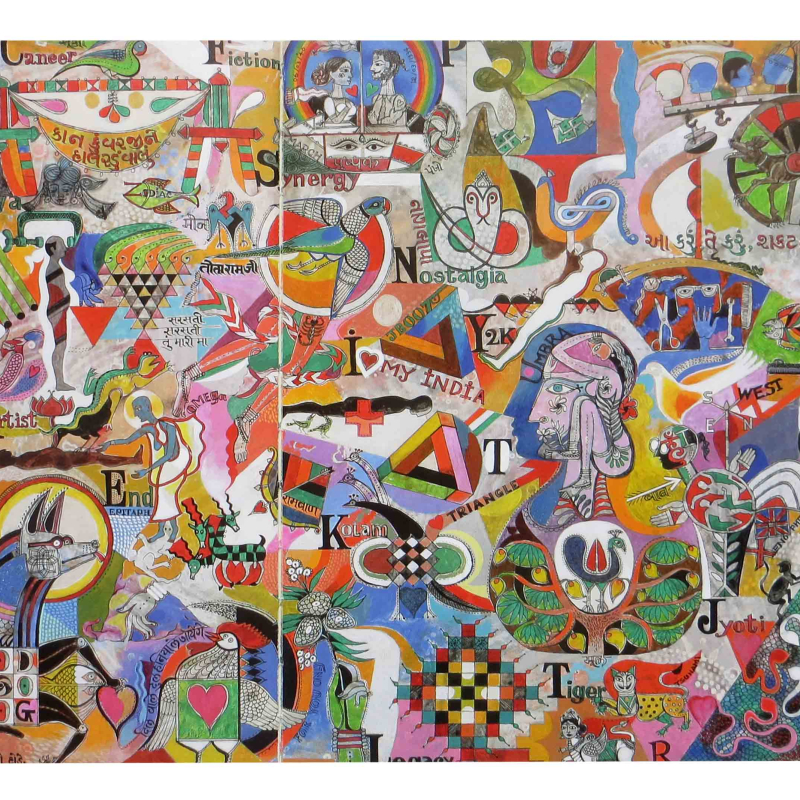The Vadodara-based Jyoti Bhatt, a veteran printmaker, painter and photographer, and a versatile artist, mentor and educator to many, has taught at Vadodara’s famous Art School, known as the Faculty of Fine Arts for more than three decades. A number of students, artists and professionals have benefitted from his thorough guidance and knowledge in the fields of painting, printmaking, drawing, design and photography. He is known to be one of the pioneers in the field of printmaking in the country and is credited with having given a direction for the field to grow further, and has influenced and inspired numerous art pupils, artists and art lovers in the country.
From early childhood, Jyoti Bhatt was fascinated with birds, which became the subject of his early experimentations in drawing and sketching. During adolescence, he developed a habit of reading the Kumar monthly, published by Kalaguru Ravishankar Raval, which also drew him closer to his calling as an artist. In 1950 he was among the first batch of students to study under the great artist-teachers such as N.S. Bendre, Shankho Chaudhuri and K.G. Subramanyan at the M.S. University’s Fine Arts Faculty. During his study at the M.S. University, between 1955 and 1961, Bhatt came to know Gulam Mohammed Sheikh, an artist, art critic and Gujarati poet, and through him got the opportunity to publish his illustrations and to work on cover pages in the publications brought out by Gulam Sheikh’s literary friends.
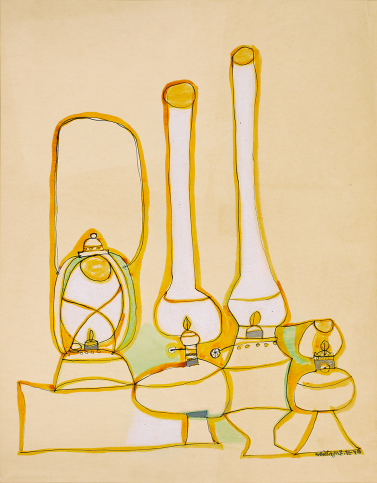
'Lamps' (1957); watercolour, acrylic and pen and ink on paper
In 1961–62, Jyoti Bhatt received a scholarship to continue his studies at the Accademia Di Belle Arti, Naples, Italy, under the Italian Government, and later in 1964–66 he learnt printmaking at the Pratt Institute and Pratt Graphic Art Center, New York, specializing in Graphics, under Fulbright & John D Rockfeller II Grants. During these visits abroad Bhatt was exposed to experimentation with diverse materials as well as to a more diverse language than that which he used to employ earlier. He has worked with an array of media, such as poster colour, watercolour and oil painting. But it was printmaking that attracted him and he became more attentive to expression through various printmaking media.
Bhatt’s stay in New York trained him in the various methods of printmaking. He tried to create a textural surface on the plate using deep etched lines, open bite areas, or many times embossing on a copper plate, as in 'Shimmering Landscape' (1964), 'Remains of the Lost Fort' (1964), where one can see his obsession with colour in an intaglio print, executed using varied rubber rollers charged with the printing inks. 'Glimmering Horizon: New York' (1964) is another mixed intaglio print, where an image is separated with a patch of bright lineation, also created using the deep textural surface in an abstract language. He used indigenous materials to create the textures—like sand, rubber, jute, linoleum, etc.—which often created a certain relief effect in combination with oil colours in the surfaces we find from his Pratt institute period, where he was constantly in contact with artists and methodologists like Antoni Tapies and Alberto Burri’s abstract art language. Such experimental works are, ‘Dark Landscape’, ‘Untitled’, or ‘Ruins of Landscape: Forgotten Place’.
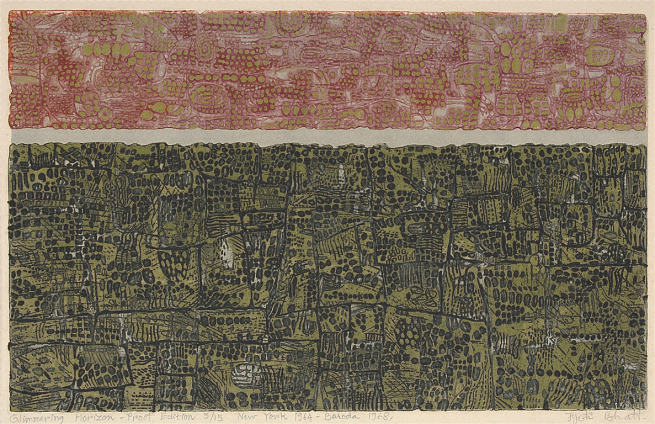
'Glimmering Horizon: New York' (1964); Mixed intaglio print
His experiments continued along with playing on 'positive and negative' spaces, dense patterns and the movement of shapes and forms. During the late '60s, Jyoti Bhatt began documenting traditional Indian craft and design using the camera, and soon it became one of his passions. For him photography is an art form, by which one can capture images, the moments and the essence of the thought in a picture by clicking a button of the camera. His direct and simply composed photographs soon started receiving acclaim from several quarters and brought him national and international awards. He joined the artistic initiative ‘Group 1890’ as one of the founder members. He realized that folk art has many strands which strengthen one another. 'Each work of art provides an opportunity of creativity, and refines human sensibilities and responses. Living within a creative network, an individual artist attains a special stature and refinement. The disappearance of the network, with the breakdown of traditional cultures, is bound to cause cultural impoverishment,' he says.
Be it Bhatt’s intaglio print or a serigraph print, his works bear proof of the deep influence of the indigenous art of Saurashtra—rich visuals and artistic motifs. Use of the local language in his art is a kind of peculiar exploration of vernacular art language never reflected in Indian art so extensively before. Motifs and images like ‘Chandamama’, ‘Surajbapa’, ‘Parrot’, ’Peacock’, ‘Nag Devta’, local scenes of people playing games like chausar, woman with earthen pots on the head, the Banni houses of the Kutch region of Gujarat decorated with the mirror along with mud on the walls and so on had been adopted and made use of by Bhatt with an aesthetic sense, as ornamentation. Bhatt’s 'The Fly' is a free image using two women figures in the central part of the composition, over which is superimposed a blue fly in the extreme centre. The composition itself reminds us of the form of a mandala diagram. These compositions are replete with popular imagery as it comes from his surroundings, from Jain mythology, mandalas, newspapers, hoardings, cinema posters and wedding invitation cards, erotic imagery from porn films and so on, which are often used to suit the situation and the composition.
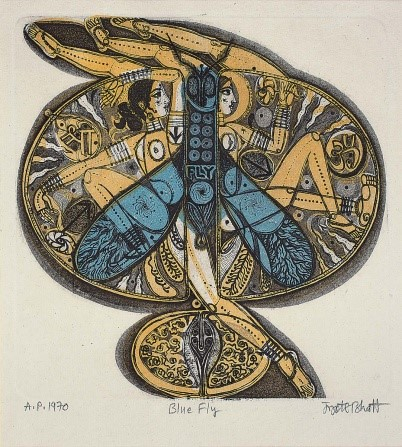
'The Blue Fly' (1970); Intaglio print
Another integral part of his compositions are words that fill gaps between visuals. Interspersed through most of his works are words, lines from a bhajan or numbers, in response to the stories and situations which converse and create suitable meanings. An example is one of his earliest paintings, done at the age of 12, which depicts an 'untouchable' man on the road, entitled, 'Chheta R’ejo'. The story being that while passing on a street, untouchable castes were required to say loudly, 'Chheta r’ejo Mai Baap '('Keep away, Mother and Father') to warn the upper caste people of their presence so as to prevent ‘pollution’ by physical contact or even with their shadow on the ground.
Text and words such as ‘DOG’, ‘GOD’, ‘SATI’, ‘SITA’ and many more phrases, proverbs and words from Indian languages are used to add meaning to the images, which are sometimes taken from popular culture and the traditional culture of the region that in some way leave a mark on the onlooker and also awaken an understanding of the deeper philosophy of life. This shows Bhatt’s concern to reinterpret and to bring the heritage of folk and tribal art forms into the mainstream and contemporary memory.
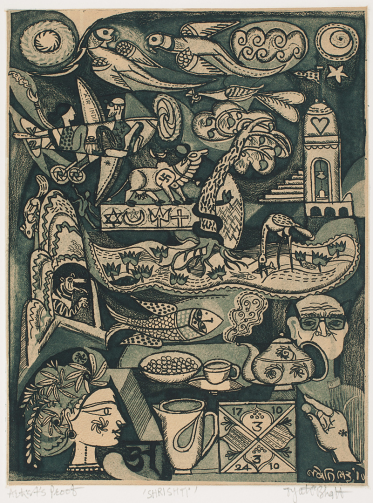
'Srushti' (2010); Intaglio print
Jyoti Bhatt’s artistic expressions emerge from the sketchbooks and diaries which he has maintained over a period of time. These diaries are actual resources for him, wherein he notes all his observations, and writes and comments on different subjects and draws the basic sketches as they come to his mind. In a way, it helps him not to forget the instant ideas or thoughts that he absorbs, and later he begins with the exploration of new forms of art in his studio where he analyses, experiments, extends and explores that thought or idea accordingly, using an appropriate medium and materials. The narrative self leaves remarks with interpretative signs and symbols, along with decorative figuration.
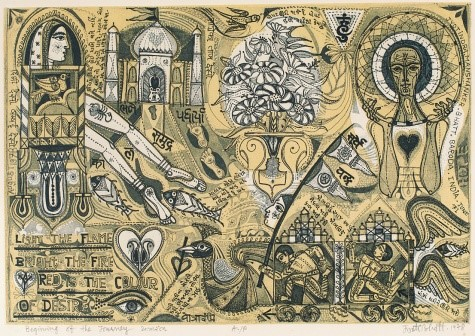
'Beginning of the Journey' (1978); Intaglio print
In 1964–66, Bhatt started depicting the self in the form of a face. During his study in the USA, he produced artworks like 'Self Portrait in New York' (1964), and 'Man Under the Sky' (1965), where the human face is the symbolic imaginative ‘self’ in quest of individualistic reference to present to society, and becomes an extended approach towards his own cultural representation. The iconic self became his prime element in these works, and portrays his hidden messages in terms of social values and the human condition in different situations. In these artworks again it is observed that text and textures are sometimes juxtaposed with the face, images like the peacock are often visualised, or sometimes the same image is repeated in the opposite direction, which creates diverse significant languages to communicate with the audience. There are elements such as an arrow, suggesting a direction, or the symbols of Indian deities, which also show how much Bhatt’s artworks are rooted in the Indian. The use of photographic images was also integrated with different serigraphic images.
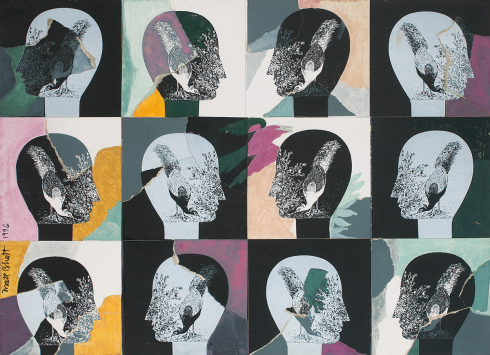
Untitled (1996); Collage with acrylic, paper and screen print pasted on mount board
The self is also masked by various forms such as the parrot, dog, an arrow or a pundit. These elements have their own significance as symbols, e.g., the parrot signifies erotic love. The erotic representation of humans can be seen in the artwork, 'Purush–Prakriti', where the power of creation appears in copulating figures, snakes, fish, scorpions and the spread-out legs of a woman. Various philosophical references in Bhatt’s work can be traced to Hindu mythology or Tantric elements, which links human existence and evolution to the constant principles of Shiva–Shakti. Jyoti Bhatt has covered a wide range of his concerns towards life, such as human desire, self-importance, fear, pain, fantasy, life and death, in varied ways in his works.
Jyoti Bhatt was involved in documentative photography of the folk and living traditions of India until 1995. Along with this documentation he continued to work in various printmaking media. Thereafter he started exploring the aesthetics of digital printmaking. Seeing the growing possibilities for producing multiple copies for the public with the use of technology, much as in traditional printmaking, Bhatt started utilizing the capacities of the computer.
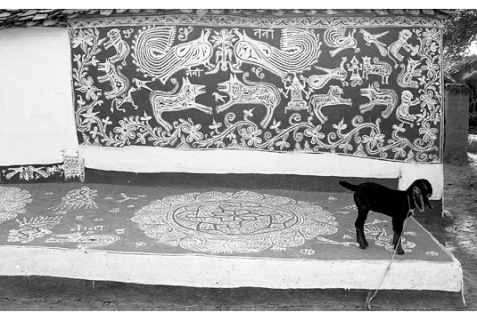
Photo-documentation work
For the last decade Jyoti Bhatt has been creating works in various media, though presently he suffers from weak eyesight. And although he works on the computer with the help of an assistant, he still keeps his diaries or sketch books, which serve as a storehouse for his thoughts or ideas, a reference book where he scribbles and stores cut-outs from newspapers or magazines or any relevant material that he might convert into a piece of art. Bhatt tends to interpret things in multiple ways, with different meanings, in reference or in situation, which one could read in terms of one’s own understanding. From a technical point of view, Jyoti Bhatt is the most versatile among Indian printmakers, given his experiments in the medium with use of the image in various ways—old images inserted in new print works, cutting the plates and arranging them in a certain way, or repeating an image to create artworks that are open to individual interpretation. His early etched plates have unique characteristics—meticulously carved surfaces using line and aquatint and prominent texturing. The compact imageries have interconnections which speak of his interest in the expressive manner, and attract the viewer to enter the image and engage in a dialogue with it.
Since 1969, Jyoti Bhatt maintained diaries where he put together his thoughts, ideas, observations, bibliographical references and sketches. Many of his diaries include notes based on his travels to various locations to document the living traditions of India. These diaries offer an interesting insight into the way Jyoti Bhatt was shaped and influenced by the world he experienced and observed around him. This diary speaks of the living thoughts and interpretations by him on varied subjects. All such important documentation, i.e., photographic works, diary, writing and artworks, are available online at Asia Art Archive
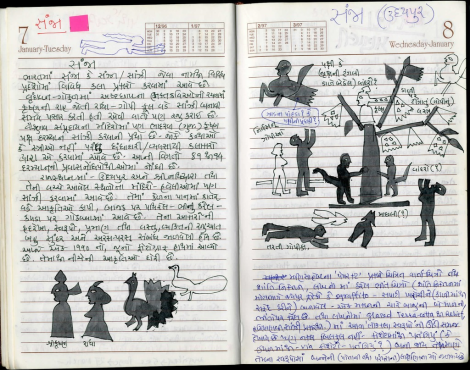
A page from Jyoti Bhatt's diary
Jyoti Bhatt’s diaries are very important to understand his devotion to art and also might serve as a source for present researchers. These diaries have entries on small details about people’s cultures, traditions, festive moments starting from 1969. The creative inner self of Jyoti Bhai, even at the age of 83, still has immense inherent zest to pursue, and capture expressive moments, adding appropriate meanings with his creative urge, in his art, which continues to inspire and influence his numerous friends, art lovers and art practitioners around the world.
